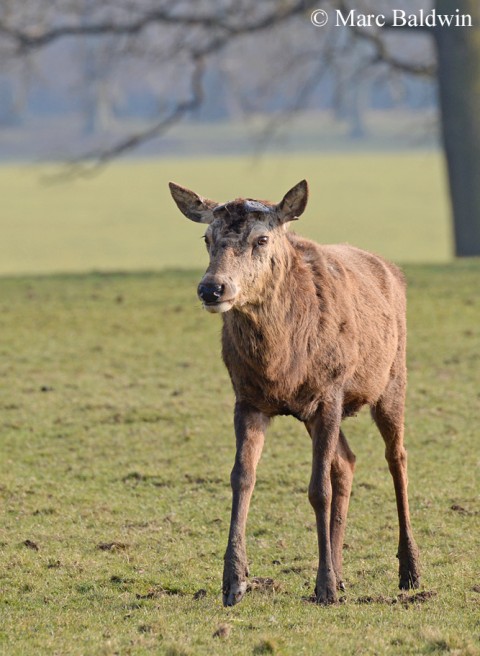Sexing Red deer

In most cases, males of at least a year old are easily separated from females by the presence of antlers, which develop from bony structures on the crown of the head called pedicles. Even once antlers have been cast, the males are left with prominent bleeding stumps that rapidly heal over and antler bud growth proceeds at speed. Some authors point to it being possible to sex newborn calves, even foetuses, based on the swellings that will eventually form the pedicles, and, in 1973, deer biologist Gerald Lincoln described how he was able to sex foetuses as young as 60 days old (i.e., about six months before birth) by looking at head swellings. There are, however, some rare instances where males fail to develop antlers altogether, usually because they fail to develop normal pedicles -- these animals are referred to as hummels or notts, and all other sexual development seems normal. In some other species (e.g., Roe deer, Capreolus capreolus), old females are known to grow small antlers, but I know of no similar reports in Red deer.
Closer inspection of the animal may reveal the penis sheath called a prepuce -- the external genitalia is evident in foetal deer by just under two months old -- and, especially during the rut, a mature male's underside will often be stained with urine. Mature males will often sport a mane of longer hair in their winter coat. Females may be identified by the presence of swollen mammae during the calving season. Males are typically larger and heavier than females, and differences may sometimes be noticeable in the shape of the head. In a 2003 paper to the journal Acta Theriologica, for example, a team of Spanish biologists demonstrated some sexual differentiation in the mandible (i.e., lower jaw). The researchers studied 126 mandibles and found that those from females were fully grown more than a year before those of males. The data also show that several of the measurements, including the angle of the jaw and size of some sections at the back of the jaw, were consistently larger in males than females. In their paper, they note that significant variation was also observed in association with climatic factors, however, which may lead to some ambiguity in assigning sex. In his book Kia: A study of Red deer, Ian Alcock noted that Red deer have very elongated faces and that youngsters have quite short faces that elongate as they get older such that adult females have very long noses.
Outside of simply studying a deer's appearance, it may sometimes be possible to sex them by proxy using their droppings. One study, published in 1994, demonstrated that it was possible to reliably sex Fallow deer (Dama dama) on the basis of their faecal pellets, although no similar data were included for Red deer. SImilarly, a study published during 2005 by a team led by Douglas Tolleson at the Texas A&M University demonstrated that it was possible to identify both sex and species of deer by bouncing infrared light off their scat pellets; a process known as Near Infrared Reflective Spectroscopy (NIRS). The team had mixed success with their samples, however, being able to identify Fallow more consistently than Red and females with greater accuracy than males. More recently, in 2008, a group of Chinese biologists were able to use genetic profiling to correctly assign the sex of 108 (59%) of the 183 faecal samples collected from captive Red deer.

During the autumn rut, a single may will attempt to try and hang on to a group, or harem, of females (see Breeding Biology), which can assist sexing, while outside of the rut mature males tend to spend the spring and summer in single-sex groups (see Behaviour and Social Structure). Males are called stags or harts, females are hinds and the young are calves. Intriguingly, in his 1966 book Dawn, Dusk and Deer, former New Forest Deputy Surveyor Arthur Cadman noted how "few sports men use the correct terms [for red deer] today", referencing that the term stag was reserved for younger males "not fit to be shot". Instead, he referred to mature animals being muckle harts. Muckle appears to be derived from meikle, a Scottish dialect word meaning "much", "large" or "great", while hart is from the Old English heorot, meaning a deer, and in medieval hunting parlance it referred to a mature animal.